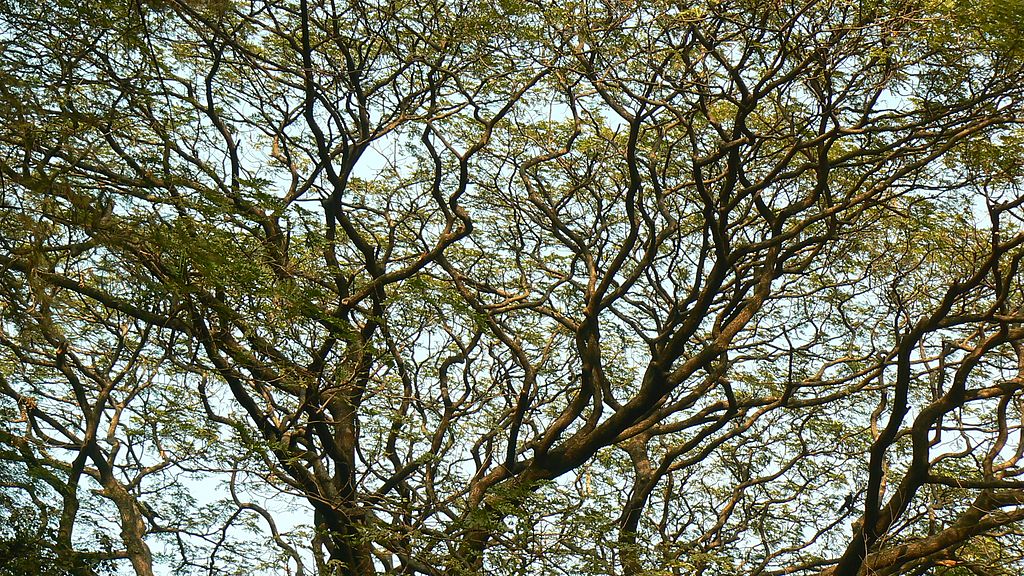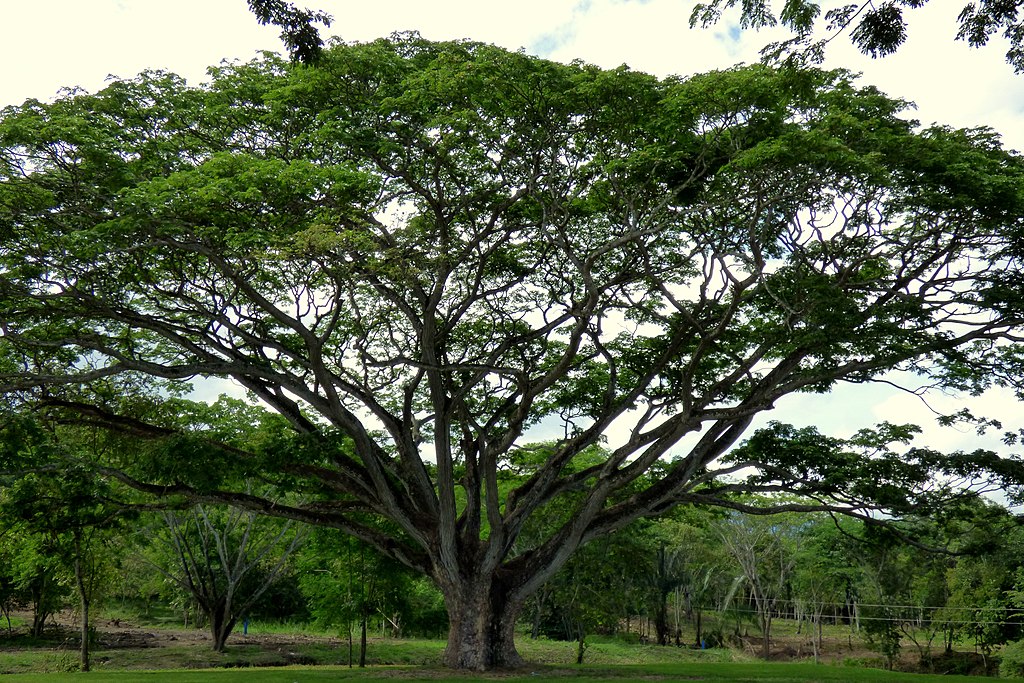Common: Rain tree, Monkeypod, Five o'clock tree
The rain tree has started to catch on as a popular bonsai species in recent years, and its for good reasons:
- The branches grow naturally with a lot of movement and taper, giving even young bonsai a good look.
- The leaves are tiny, helping with forced perspective.
- They respond to pruning with tons of back budding.
- The bark quickly takes on a grayed and cracked look.
- They grow pretty well indoors - especially if brought outside in the warm months.
Because of these reasons, the rain tree has been growing in popularity species for bonsai. Their vigorous growth and robust nature make them a good choice for new growers, and their elegant appearance has earned them a place with experienced growers.

The rain tree (Samanea saman) is ubiquitous across tropical regions and has become known by many names in many languages. They are called 'monkeypod trees' in Hawaii, 'rain trees' in South American and many other regions, marmar in New Guinea, pukul lima or 'five o'clock tree' in Malaysia, etc. These are all synonyms or cultivars of the Samanea saman.
Besides all the different common names for the tree, there is a lot of confusion about the common name 'rain tree' in the bonsai community in general. The common name 'rain tree' is applied to Samanea saman trees and has been misapplied to completely unrelated trees that are actually members of the Chloroleucon tortum species. The original source of confusion in the bonsai community was a misidentification of an imported species. While the community has recognized the error, the names are still being misapplied for some reason. This article is about Samanea saman tree.
Rain trees in nature
Saman trees are native to South America and spread into Central America and the Caribbean. Introduced to tropical Asia, Australia, and the southern Pacific Islands, they have found new homes across much of the tropical world. The Saman tree thrives in sunny and frost-free environments, where temperatures remain well above freezing.
One of the most remarkable features of the tree is that its leaves fold shut at night and when it rains. Scientists are not entirely sure why the tree does this, but it may be the origin for the name 'rain tree' - the other possible reason is that the tree produces dewy moisture droplets that can feel like rain under the canopy. It produces tiny pink flowers with a feathery texture all of the face of the canopy and sharp thorns in the branches. As a legume, its seed pods are coated with a sticky substance, human-edible, and have become part of many cultures' diets.

This tree gets big, too, routinely reaching 30m tall and occasionally up to 45m. They have wide canopies diameters of up to 90m, giving them a mushroom shape. While it is tempting to think of them as junkgle trees, their preferred habitat is dry forest, grass savanna, and on the edges of evergreen woodlands and savanna. These areas have nutrient-poor soil, high temperatures and alternate between wet and dry,
If you want to learn more about this tree, this datasheet from Centre for Agriculture and Bioscience International is an excellent resource.
Lighting
Saman trees do best with ample light - they are from the warmest and sunniest spots on earth! Place your bonsai in the brightest place you can find; a south-facing window will work great in the colder months. You can supplement with artificial grow lights if needed. Don't worry about losing some of their leaves in the colder months; this is normal.
Your rain tree bonsai will do much better if given ample outside time when warm and sunny weather. Start by placing it in a shady, protected spot and then gradually move it to more exposed locations over a few weeks. The gradual introduction will allow your tree to harden and will help to prevent sunburn or windburn.
Temperature & Humidity
Saman trees are tropical and cannot tolerate frost or temperatures near freezing. While they can survive more extreme conditions, keep them above 55F (12.7C) to avoid damage. Temperatures below 8C (45F) will likely kill them.
Tropical trees can actively grow year-round. However, it is best to give them a dormancy period if possible. To induce dormancy, move them into a cool area, between 55F (12.7C) and 60F(15.5) for 6 to 8 weeks in the wintertime. This evergreen tree loses and grows new leaves year-round. It is usual for this to accelerate during dormancy, and the tree can look rather bare before budding out for heavy spring growth. Giving them a dormant time will let your bonsai recharge and prepare for spring growth.
Human homes typically stay in the correct temperature ranges for rain trees, but indoor environments' 30-50% relative humidity can be too low. Dry forests and grass savannas sound like low humidity environments but range between 40-90% humidity. Consider Hawaii's giant monkeypod trees, and the conditions where they grow are the same as your bonsai would like. Around 60%-70% relative humidity in the spring is perfect. Raise the humidity by misting the trees daily or using a humidity tray.
Soil
Rain trees in the South American savannah grow in nutrient-poor, acidic soil that becomes seasonally waterlogged. While they are so robust that they can grow in poor soil at full size, you will want to be more careful with your bonsai version since it grows in a very constrained space. A safe bet is to use commercial bonsai soil since it is free-flowing and excels at developing roots in deprived areas.
With that said, you can easily mix your own if you know what you are doing. The essential aspects of good soil are:
- Loose - Compacted soil won't let the roots breath
- Free Flowing - Waterlogged soil will rot the roots
Saman trees thrive in soil with ample volcanic materials like pumice, lava rock, vermiculite, and perlite because these inorganic materials are lightweight, free-draining, and provide excellent aeration. Rain tree bonsais, especially young ones in training and pre-bonsai states, also benefit from organic matter mixed in the soil. We recommend a mix of 70% inorganic material (pumice, lava, vermiculite, sand, etc.) and 30% organic materials (pine/fir bark, coco coir, peat moss, composted forest products, etc.).
Saman trees prefer acidic soil pH, between 5.5 and 6.5. Adding peat moss or pine bark will lower pH (more acidic), and adding lime will raise the pH (more alkaline). Use caution when adjusting pH, and be sure to test your soil since you can easily create an environment too alkaline or too acidic for the tree to survive.
Water
Almost all bonsai can follow the same rule of thumb for watering: let the soil almost dry out between waterings but do not let it completely dry out. For summertime, you may need to water every day, depending on the size of the container, or even multiple times a day. While the weather is cool or the plant is dormant, watering will be less frequent.
Make sure to water entirely every time you water until it runs from the bottom of the pot. Water running through will help ensure that all of the soil gets wet so the roots will expand to the entire potting area, and the runoff will help remove excess salts left by chemical fertilizers.
This bonsai is a fast grower and a heavy drinker, so check it frequently.
Fertilizer
Rain tree bonsai grow best when there are ample nutrients available. Apply a balanced, water-soluble fertilizer once a week during peak growing season and once a month during the cooler seasons. Always follow the manufacturer's instructions; overfertilizing can burn the tips of the leaves, and under-fertilizing can cause sluggish growth and can eventually kill your bonsai.
Repotting
Rain tree is a vigorous root grower who will quickly fill up their pot. You should check your pot at least once a year and repot if they are root-bound. They respond well to root pruning, and you can easily create a radial root base.
Pruning & Wiring
When pruned, rain tree bonsai responds with profuse back budding and rapidly produces new shoots after a hard cutback. Always sanitize your tools before pruning any bonsai to reduce the risk of infection or cross-contamination. While there are many great where growers have wired rain trees, their natural twists and taper and heavy responses to clip-and-grow techniques mean growers often shape them without the need for wiring.
The primary concern with wiring these bonsai is that they grow so fast that the wire can cut into the bark. Remember to check the wiring frequently and remove or replace it when you see it cutting into the bark.
Propagating
Saman trees can be propagated from cuttings, though cuttings do not root as easily as many other trees. You will need to remove most of the leaves since the cutting will not have a root system to support the water required for photosynthesis until it develops roots. Place the cuttings into moist soil in a humid environment and mist them while growing roots. Cuttings from this tree will only root in warm weather. Please keep them in low light until they grow enough of a root system to support photosynthesis, which takes between 10 days and three weeks.